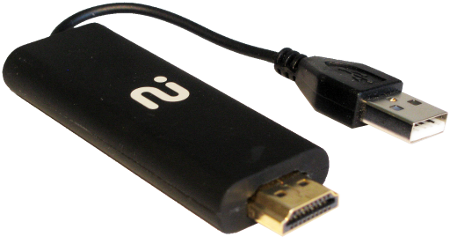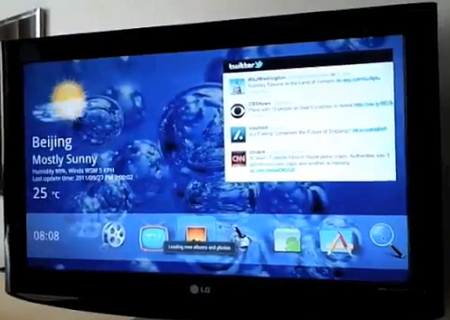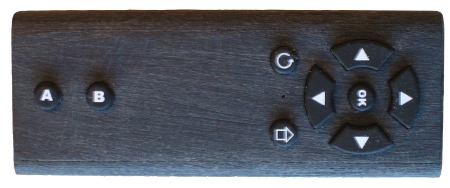HDMI dongle IPTV device supports Android 4.0
Jan 9, 2012 — by Eric Brown — from the LinuxDevices Archive — 95 viewsAlways Innovating announced a tiny open source, IP set-top box (STB) that runs Android 4.0 on a Texas Instruments OMAP4 processor clocked as high as 1.8GHz. The HDMI Dongle plugs directly into a TV's HDMI port, and provides up to 1GB of RAM, a microSD slot, Wi-Fi, Bluetooth, and a remote control that offers NFC, accelerometers, and voice control.
Developed by Always Innovating, the company that introduced the Linux-based, open platform Touch Book and Smart Book products (see farther below), the HDMI Dongle is similar in concept to the Roku Streaming Stick announced last week. Like Roku's device, the HDMI Dongle packs IP STB functionality in an HDMI dongle the size of a USB flash stick.

HDMI Dongle, with USB power cable extending to upper right
(Click to enlarge)

HDMI Dongle, Android 4.0 interface

Always Innovating founder Grégoire Gentil with HDMI Dongle in his left hand and remote in his right
The HDMI Dongle thus has the advantage of being able to plug into any TV or display device with both HDMI and USB ports, as opposed to the more selection of TVs with MHL-compliant HDMI ports. Presumably, a separate power adapter would be made available for plugging into a TV without a USB port.

HDMI Dongle PCB
(Click to enlarge)
The HDMI Dongle is based on the Texas Instruments Cortex-A9 OMAP 4 processor, clocked from 1GHz to 1.8GHz depending on the configuration, says Always Innovating. This would suggest the device supports the earlier 1GHz OMAP4430 or OMAP4460 (formerly called the OMAP4440), as well as the new 1.8GHz ready OMAP4470.
The HDMI Dongle can stream and decode 1080p H.264 video, and is compatible with services such as Netflix, Hulu, or Amazon video-on-demand, says the company. The device is also said to ship with 256MB to 1GB of RAM.
Whereas the Roku Streaming Stick appears to be limited to Wi-Fi in addition to the HDMI port, the HDMI Dongle offers those features as well as a microSD card and Bluetooth, says Always Innovating. All these features, as well as the available camera interface and "battery management," lend themselves to mobile tablet versions of the device.

HDMI Dongle remote
Always Innovating founder Grégoire Gentil, demonstrating HDMI Dongle Android 4.0 interface
Source: Always Innovating
(Click to play)
Plugging the HDMI Dongle into a TV
Source: Always Innovating
(Click to play)
Always Innovating's flagship product was the BeagleBoard-based Touch Book, a Linux-ready, open source device announced in March 2009, with shipments beginning in August of that year. The Touch Book was a tablet that could be converted into a netbook by connecting to a keyboard — an approach to device design that has since become fairly common.
 The company in 2010 followed up with a smaller, but somewhat similar, Smart Book mobile device (pictured). Built around a 1GHz Texas Instruments DaVinci DM3730 processor, the highly modular device could be bought as a mobile Internet device (MID) called the Mini Book, or as a tablet computer with the MID embedded in the back of the device, constituting a second, back-facing screen (right). This tablet/MID combination could then can be converted into a netbook by plugging it into a USB- and Bluetooth-enabled keyboard.
The company in 2010 followed up with a smaller, but somewhat similar, Smart Book mobile device (pictured). Built around a 1GHz Texas Instruments DaVinci DM3730 processor, the highly modular device could be bought as a mobile Internet device (MID) called the Mini Book, or as a tablet computer with the MID embedded in the back of the device, constituting a second, back-facing screen (right). This tablet/MID combination could then can be converted into a netbook by plugging it into a USB- and Bluetooth-enabled keyboard.
Availability
The HDMI Dongle design is available now to OEMs, says Always Innovating. The first HDMI Dongle product is expected to ship this summer, at prices ranging from $49 to $99. More information may be found at the Texas Instruments booth at CES this week in Las Vegas, as well as the Always Innovating website.
This article was originally published on LinuxDevices.com and has been donated to the open source community by QuinStreet Inc. Please visit LinuxToday.com for up-to-date news and articles about Linux and open source.